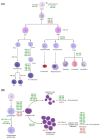MiRNAs in Hematopoiesis and Acute Lymphoblastic Leukemia
- PMID: 36982511
- PMCID: PMC10049736
- DOI: 10.3390/ijms24065436
MiRNAs in Hematopoiesis and Acute Lymphoblastic Leukemia
Abstract
Acute lymphoblastic leukemia (ALL) is the most common kind of pediatric cancer. Although the cure rates in ALL have significantly increased in developed countries, still 15-20% of patients relapse, with even higher rates in developing countries. The role of non-coding RNA genes as microRNAs (miRNAs) has gained interest from researchers in regard to improving our knowledge of the molecular mechanisms underlying ALL development, as well as identifying biomarkers with clinical relevance. Despite the wide heterogeneity reveled in miRNA studies in ALL, consistent findings give us confidence that miRNAs could be useful to discriminate between leukemia linages, immunophenotypes, molecular groups, high-risk-for-relapse groups, and poor/good responders to chemotherapy. For instance, miR-125b has been associated with prognosis and chemoresistance in ALL, miR-21 has an oncogenic role in lymphoid malignancies, and the miR-181 family can act either as a oncomiR or tumor suppressor in several hematological malignancies. However, few of these studies have explored the molecular interplay between miRNAs and their targeted genes. This review aims to state the different ways in which miRNAs could be involved in ALL and their clinical implications.
Keywords: ALL subtypes; acute lymphoblastic leukemia; hematopoiesis; miRNA biomarkers; miRNAs.
Conflict of interest statement
The authors declare no conflict of interest. The funders had no role in the design of the study; in the collection, analyses, or interpretation of data; in the writing of the manuscript; or in the decision to publish the results.
Figures



Similar articles
-
The Role of miRNAs in Childhood Acute Lymphoblastic Leukemia Relapse and the Associated Molecular Mechanisms.Int J Mol Sci. 2023 Dec 21;25(1):119. doi: 10.3390/ijms25010119. Int J Mol Sci. 2023. PMID: 38203290 Free PMC article. Review.
-
MicroRNA expression profiles discriminate childhood T- from B-acute lymphoblastic leukemia.Hematol Oncol. 2019 Feb;37(1):103-112. doi: 10.1002/hon.2567. Epub 2018 Nov 27. Hematol Oncol. 2019. PMID: 30393877
-
Six Candidate miRNAs Associated With Early Relapse in Pediatric B-Cell Acute Lymphoblastic Leukemia.Anticancer Res. 2020 Jun;40(6):3147-3153. doi: 10.21873/anticanres.14296. Anticancer Res. 2020. PMID: 32487609 Free PMC article.
-
T-cell acute lymphoblastic leukemia from miRNA perspective: Basic concepts, experimental approaches, and potential biomarkers.Blood Rev. 2018 Nov;32(6):457-472. doi: 10.1016/j.blre.2018.04.003. Epub 2018 Apr 12. Blood Rev. 2018. PMID: 29703513 Review.
-
Genome-wide identification of microRNA signatures associated with stem/progenitor cells in Philadelphia chromosome-positive acute lymphoblastic leukemia.Mol Biol Rep. 2019 Feb;46(1):1295-1306. doi: 10.1007/s11033-019-04600-5. Epub 2019 Feb 2. Mol Biol Rep. 2019. PMID: 30712246
Cited by
-
Association of microRNA Polymorphisms with Toxicities Induced by Methotrexate in Children with Acute Lymphoblastic Leukemia.Hematol Rep. 2023 Nov 20;15(4):634-650. doi: 10.3390/hematolrep15040065. Hematol Rep. 2023. PMID: 37987321 Free PMC article. Review.
-
Ethnicity modifies the association between microRNA single nucleotide polymorphisms and pediatric acute lymphoblastic leukemia risk: a meta-analysis.Biomark Med. 2025 Jun;19(11):435-449. doi: 10.1080/17520363.2025.2511466. Epub 2025 May 29. Biomark Med. 2025. PMID: 40438964 Review.
-
MicroRNA Signatures: Illuminating Minimal Residual Disease Monitoring in Juvenile Myelomonocytic Leukemia - A Review.J Hematol. 2025 Apr;14(2):43-55. doi: 10.14740/jh1384. Epub 2025 Apr 25. J Hematol. 2025. PMID: 40336920 Free PMC article. Review.
-
MicroRNA in cancer therapy: breakthroughs and challenges in early clinical applications.J Exp Clin Cancer Res. 2025 Apr 21;44(1):126. doi: 10.1186/s13046-025-03391-x. J Exp Clin Cancer Res. 2025. PMID: 40259326 Free PMC article. Review.
-
Unraveling Therapeutic Opportunities and the Diagnostic Potential of microRNAs for Human Lung Cancer.Pharmaceutics. 2023 Jul 31;15(8):2061. doi: 10.3390/pharmaceutics15082061. Pharmaceutics. 2023. PMID: 37631277 Free PMC article. Review.
References
-
- Fernandes M.R., Souza Vinagre L.W.M., Rodrigues J.C.G., Wanderley A.V., Fernandes S.M., Gellen L.P.A., Alcantara A.L., Sousa B.B., Burbano R.M.R., Assumpcao P.P., et al. Correlation of Genetic Variants and the Incidence, Prevalence and Mortality Rates of Acute Lymphoblastic Leukemia. J. Pers. Med. 2022;12:370. - PMC - PubMed
-
- Jaime-Perez J.C., Jimenez-Castillo R.A., Pinzon-Uresti M.A., Cantu-Rodriguez O.G., Herrera-Garza J.L., Marfil-Rivera L.J., Gomez-Almaguer D. Real-world outcomes of treatment for acute lymphoblastic leukemia during adolescence in a financially restricted environment: Results at a single center in Latin America. Pediatr. Blood Cancer. 2017;64:e26396. - PubMed
-
- Nunez-Enriquez J.C., Barcenas-Lopez D.A., Hidalgo-Miranda A., Jimenez-Hernandez E., Bekker-Mendez V.C., Flores-Lujano J., Solis-Labastida K.A., Martinez-Morales G.B., Sanchez-Munoz F., Espinoza-Hernandez L.E., et al. Gene Expression Profiling of Acute Lymphoblastic Leukemia in Children with Very Early Relapse. Arch. Med. Res. 2016;47:644–655. - PubMed
Publication types
MeSH terms
Substances
Grants and funding
LinkOut - more resources
Full Text Sources

